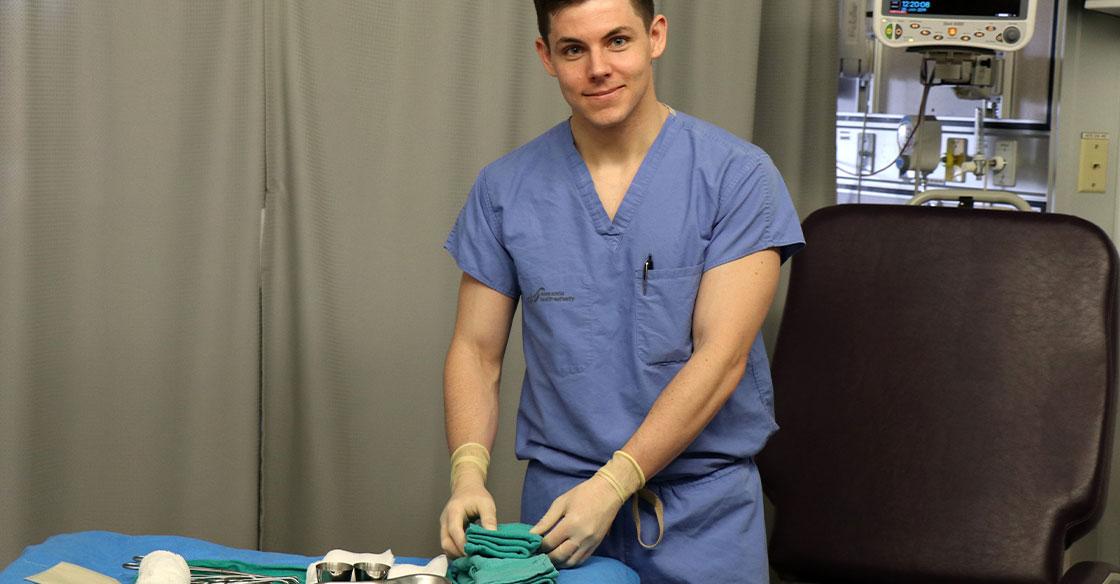
Originally published on qe2times.ca.
Dr. Jack Rasmussen knows he came to the QEII Health Sciences Centre at the right time, with the right skills.
A specialist in burn care, Dr. Rasmussen has unique training as both a plastic surgeon and an intensivist or critical care doctor, allowing him to follow major burn patients from the time they enter hospital, through their reconstructive surgeries, all the way to their recovery — both in and out of hospital.
“Dr. Rasmussen is our link between the intensive care unit and the plastic surgery team,” says Dr. Jason Williams, a QEII plastic surgeon. “We now look to him as the burn care leader in the institution.”
Last July, Dr. Rasmussen became Canada’s first cross-appointed physician in plastic surgery and critical care. As the only adult health care centre in the Maritimes to house an inpatient burn care centre, this is an important step in improving how the QEII delivers care to burn patients.
“I feel lucky that I get to do what I have a passion for, and I get to do it here in Halifax.” - Dr. Jack Rasmussen
“We are able to deliver more comprehensive care to patients now,” says Dr. Williams. “Having a dedicated burn care specialist in this centre is something we have been hoping for.”
Dr. Rasmussen was the type of physician the QEII was looking for. He had the right training and he had developed a keen interest in caring for burn patients — who are often some of the sickest in the hospital, and require years of follow-up, monitoring and care.
“It is challenging work,” Dr. Rasmussen says. “Some of these people will become my patients for life.”
Raised in Antigonish, Dr. Rasmussen went to St. Francis Xavier University, where he was taught anatomy and physiology by his father, Dr. Roy Rasmussen. He went on to pursue medical school and his plastic surgery residency at Dalhousie University. During his second year of residency, he did a rotation in the intensive care unit and helped care for several patients with severe burns. He liked the intensity and complexity of the work.
After his residency, Dr. Rasmussen completed a two-year fellowship in critical care medicine, with a portion of his training devoted to burn care. He trained at the Ross Tilley Burn Centre, the country’s largest centre of its type, based in Toronto. One of the benefits of working in a major burn care centre is that he not only became part of a network of some of the best burn care specialists in the country, but also learned new techniques and technologies to improve the way care is delivered.
One of the advances he brought back to Halifax was an innovative way to use a synthetic “skin substitute” product called Integra. The product helps patients rebuild the deep layer of their skin, leading to fewer surgeries, less scarring and less time in hospital.
Dr. Rasmussen is also using a new skin grafting machine called the Meek mesher, acquired through the efforts of previous burn unit director Dr. John Stein, and funded by the QEII Foundation and the Nova Scotia Firefighters Burn Treatment Society. Using the machine, Dr. Rasmussen can take a relatively small amount of healthy skin from one part of a major burn patient’s body and spread it over a larger area of their body, helping the patient heal faster with fewer surgeries.
“I feel lucky that I get to do what I have a passion for, and I get to do it here in Halifax,” Dr. Rasmussen says. “I wanted to stay in my home province and help to modernize our burn care.”
Since July, Dr. Rasmussen has been involved in the care of all burn patients at the QEII. While the health centre typically sees as many as 15 major burn cases a year (patients who have more than 20 per cent of their skin burned), he also sees between three and five new minor to moderate burn patients a week in his outpatient clinic. When he’s not busy treating burns, Dr. Rasmussen is taking a leadership role in delivering wound care at the health centre.
Dr. Ward Patrick, senior medical director of the province’s critical care program, is certain his colleague’s arrival at the QEII will have a positive impact on patient care. Having worked in critical care in Halifax for the past 25 years, Dr. Patrick recognizes the need to remain current with burn care practices.
“We’ve been lucky that Dr. Rasmussen has joined us,” says Dr. Patrick. “He is making a difference for patients at a critical time in their lives.”